L2MP based forwarding across vPC peer-link in Carmel ASIC based switches(Nexus 5548/5596)
Available Languages
Contents
Introduction
In vPC topologies user traffic will be seen on peer-link only for orphan port traffic or flooded traffic (unknown unicast, broadcast, multicast). For this flood traffic, there is a requirement that switches make sure flood traffic received on one leg of the vPC is not sent back on the other vPC leg so that packets are not sent back towards source or duplicated to other vPCs.
In Carmel based switches (Nexus 55xx), vPC loop avoidance implementation is different compared to Gatos (Nexus 5010/5020) based implementation which uses a separate internal MCT VLAN for flooded traffic across peer-link.
Because Carmel based switches support L2MP or fabricpath, engineering decided to use L2MP based forwarding across the peer-link. With this model, vPC primary switch will have a switch-id of 2748(0xabc) while the vPC secondary will have a switch-id of 2749(0xabd). The Emulated switch-id of 2750(0xabe) will be used as source switch-id for frames which ingress a vPC but sent across the peer-link. All ports on the vPC primary will be members of FTAG 256 while that on the vPC secondary will be members of FTAG 257. In vPC primary switch, only orphan ports will be members of FTAG 257 while in the vPC secondary switch, orphan ports will be members of FTAG 256.
Prerequisites
Requirements
There are no specific requirements for this document.
Components Used
This document is not restricted to specific software and hardware versions.
Conventions
Refer to Cisco Technical Tips Conventions for more information on document conventions.
Loop avoidance
For broadcast/unknown unicast/multicast frames coming into vPC primary switch, they will be sent out with a FTAG of 256 across the peer-link. When the vPC secondary switch gets this frame across the vPC peer-link, it inspects the FTAG and since its 256, the vPC secondary switch will only send it out to FTAG 256 members which will be orphan ports only. For flood traffic from vPC secondary, it will be sent with FTAG of 257 and when the vPC primary switch gets this frame, it sends the received flood frame only to members of FTAG 257 which will be orphan ports only. This is how Carmel based switches implement vPC loop avoidance.
In order to deep dive L2MP/FTAG based forwarding of flood frames across peer-link, this topology is used:
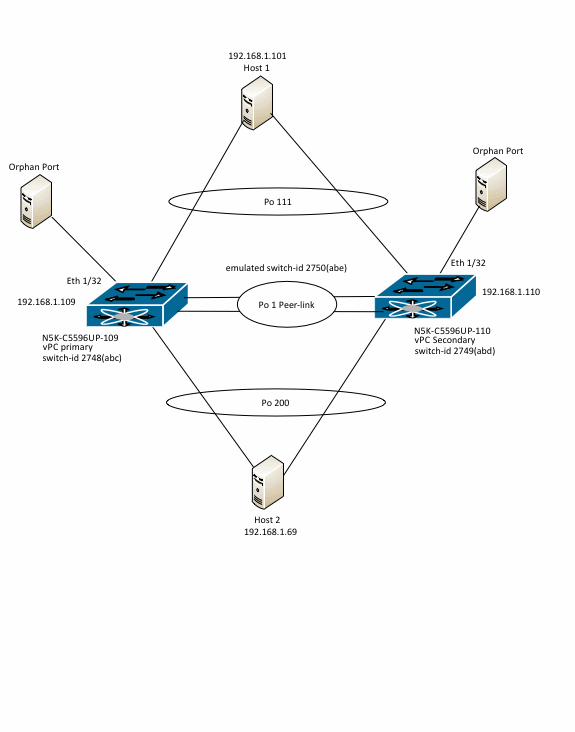
N5K-C5596UP-109 and N5K-C5596UP-100 are a vPC pair of Nexus 5596 switches running NX-OS 5.2(1)N1(2a). N5K-C5596UP-109 is the vPC primary switch and N5K-C5596UP-110 is the vPC secondary switch. Port-channel 1 is the vPC peer-link. The IP addresses shown belong to interface VLAN 1 of the switches. Host 1 and Host 2 are Cisco switches connected via vPC in VLAN 1. These are called host 1 and host 2 in this document. There is orphan port in VLAN 1 connected to Eth1/32 on both switches.
Here is some command output from the switches:
N5K-C5596UP-109# show vpc
Legend:
(*) - local vPC is down, forwarding via vPC peer-link
vPC domain id : 2
Peer status : peer adjacency formed ok
vPC keep-alive status : peer is alive
Configuration consistency status : success
Per-vlan consistency status : success
Type-2 consistency status : success
vPC role : primary
Number of vPCs configured : 2
Peer Gateway : Enabled
Peer gateway excluded VLANs : -
Dual-active excluded VLANs : -
Graceful Consistency Check : Enabled
Auto-recovery status : Disabled
vPC Peer-link status
---------------------------------------------------------------------
id Port Status Active vlans
-- ---- ------ --------------------------------------------------
1 Po1 up 1
vPC status
----------------------------------------------------------------------------
id Port Status Consistency Reason Active vlans
------ ----------- ------ ----------- -------------------------- -----------
111 Po111 up success success 1
200 Po200 up success success 1
N5K-C5596UP-109# show platform fwm info l2mp myswid
switch id
-------------------------------------------------------------------
switch id manager
-------------------------------------------------------------------
vpc role: 0
my primary switch id: 2748 (0xabc)
emu switch id: 2750 (0xabe)
peer switch id: 2749 (0xabd)
N5K-C5596UP-109# show vpc orphan-ports
Note:
--------::Going through port database. Please be patient.::--------
VLAN Orphan Ports
------- -------------------------
1 Eth1/32
N5K-C5596UP-110# show vpc
Legend:
(*) - local vPC is down, forwarding via vPC peer-link
vPC domain id : 2
Peer status : peer adjacency formed ok
vPC keep-alive status : peer is alive
Configuration consistency status : success
Per-vlan consistency status : success
Type-2 consistency status : success
vPC role : secondary
Number of vPCs configured : 2
Peer Gateway : Enabled
Peer gateway excluded VLANs : -
Dual-active excluded VLANs : -
Graceful Consistency Check : Enabled
Auto-recovery status : Disabled
vPC Peer-link status
---------------------------------------------------------------------
id Port Status Active vlans
-- ---- ------ --------------------------------------------------
1 Po1 up 1
vPC status
----------------------------------------------------------------------------
id Port Status Consistency Reason Active vlans
------ ----------- ------ ----------- -------------------------- -----------
111 Po111 up success success 1
200 Po200 up success success 1
N5K-C5596UP-110# show platform fwm info l2mp myswid
switch id
-------------------------------------------------------------------
switch id manager
-------------------------------------------------------------------
vpc role: 1
my primary switch id: 2749 (0xabd)
emu switch id: 2750 (0xabe)
peer switch id: 2748 (0xabc)
N5K-C5596UP-110# show vpc orphan-ports
Note:
--------::Going through port database. Please be patient.::--------
VLAN Orphan Ports
------- -------------------------
1 Eth1/32
Now lets check on default FTAGs used and its members.
N5K-C5596UP-109# show platform fwm info l2mp ftag all
L2MP FTAG
-------------------------------------------------------------------
ftag[0x9565b1c] id: 256 (0x100)
Topology ID: 0x111
Ftag flags: 0 (invalid ftag-flags)
Is stale: FALSE
ftag_mask[0x973eca4]
ifindex array:
0x160000c7 0x1600006e 0x1a01f000
0x15010000 0x15020000 0x1600007e
0x16000000
ifmap[0x88400fc]
ifmap idx 6: ref 1, lu_mcq_alloced 0, lu_mcq 15 (orig 15) 'not pruned'
ifmap idx 6: prune_ifmap 0, prune ref count 0, prune_unvisited 0
ifmap_idx 6: oifls_macg_ref_cnt 0, num_oifls 0
ifmap idx 6: ifs - sup-eth1 sup-eth2 Po200 Po1 Po111 Eth1/32 Po127
rpf: (0x0)
alternate: 0
intf:
Po1 (0x16000000)
ftag_ucast_index: 1
ftag_flood_index: 1
ftag_mcast_index: 32
ftag_alt_mcast_index: 48
-------------------------------------------------------------------
ftag[0x9565e3c] id: 257 (0x101)
Topology ID: 0x111
Ftag flags: 0 (invalid ftag-flags)
Is stale: FALSE
ftag_mask[0x95612b4]
ifindex array:
0x1a01f000 0x15010000 0x15020000
0x16000000
ifmap[0x883b81c]
ifmap idx 11: ref 1, lu_mcq_alloced 0, lu_mcq 14 (orig 14) 'not pruned'
ifmap idx 11: prune_ifmap 0, prune ref count 0, prune_unvisited 0
ifmap_idx 11: oifls_macg_ref_cnt 0, num_oifls 0
ifmap idx 11: ifs - sup-eth1 sup-eth2 Po1 Eth1/32
rpf: (0x0)
alternate: 1
intf:
Po1 (0x16000000)
ftag_ucast_index: 0
ftag_flood_index: -1
ftag_mcast_index: 0
ftag_alt_mcast_index: 0
-------------------------------------------------------------------
N5K-C5596UP-109#
N5K-C5596UP-110# show platform fwm info l2mp ftag all
L2MP FTAG
-------------------------------------------------------------------
ftag[0x956a99c] id: 256 (0x100)
Topology ID: 0x111
Ftag flags: 0 (invalid ftag-flags)
Is stale: FALSE
ftag_mask[0x98b4764]
ifindex array:
0x16000066 0x1a01f000 0x15010000
0x15020000 0x16000000
ifmap[0x9635adc]
ifmap idx 4: ref 1, lu_mcq_alloced 0, lu_mcq 15 (orig 15) 'not pruned'
ifmap idx 4: prune_ifmap 0, prune ref count 0, prune_unvisited 0
ifmap_idx 4: oifls_macg_ref_cnt 0, num_oifls 0
ifmap idx 4: ifs - sup-eth1 sup-eth2 Po103 Po1 Eth1/32
rpf: (0x0)
alternate: 1
intf:
Po1 (0x16000000)
ftag_ucast_index: 1
ftag_flood_index: -1
ftag_mcast_index: 32
ftag_alt_mcast_index: 48
-------------------------------------------------------------------
ftag[0x956acbc] id: 257 (0x101)
Topology ID: 0x111
Ftag flags: 0 (invalid ftag-flags)
Is stale: FALSE
ftag_mask[0x97359bc]
ifindex array:
0x160000c7 0x16000066 0x1600006e
0x1a01f000 0x15010000 0x15020000
0x1600007e 0x16000000
ifmap[0x95c624c]
ifmap idx 7: ref 1, lu_mcq_alloced 0, lu_mcq 16 (orig 16) 'not pruned'
ifmap idx 7: prune_ifmap 0, prune ref count 0, prune_unvisited 0
ifmap_idx 7: oifls_macg_ref_cnt 0, num_oifls 0
ifmap idx 7: ifs - sup-eth1 sup-eth2 Po200 Po103 Po1 Po111 Eth1/32 Po127
rpf: (0x0)
alternate: 0
intf:
Po1 (0x16000000)
ftag_ucast_index: 0
ftag_flood_index: 1
ftag_mcast_index: 32
ftag_alt_mcast_index: 48
-------------------------------------------------------------------
Test 1: Broadcast ARP traffic coming into vPC secondary
A non-existent IP 192.168.1.199 is pinged from host 1(192.168.1.101). Due to this, host 1 keeps sending out a broadcast ARP request asking "who is 192.168.1.199". Host 1 happens to hash this broadcast traffic to vPC secondary switch N5K-C5596UP-110, which in turn floods it to all ports in VLAN 1 including Po1 which is the vPC peer-link.
A TX SPAN of Port-channel 1 is captured to look at the fabric path headers of this ARP broadcast which is a multi-destination frame in FP terminology. Look at the fabric path header of this multi-destination frame.
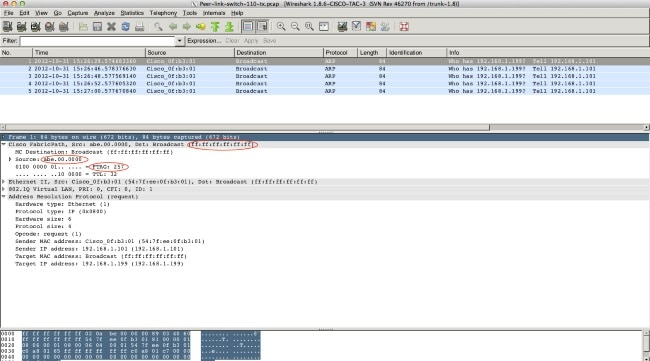
-
Because the frame ingresses via a vPC(vPC 111), source switch-id is abe.00.0000.
-
Destination is a broadcast MAC FF:FF:FF:FF:FF:FF
-
FTAG is 257.
When this frame comes into the vPC primary switch, it will inspect the FTAG 257. Because only orphan ports are members of FTAG 257, this broadcast ARP frame will only be sent to Eth 1/32.
Test 2: Unknown unicast frame coming into vPC secondary
In order to introduce unknown unicast traffic, on host 1, I set up a static ARP for 192.168.1.99 with a static MAC of 0001.0002.0003 and do a ping to 192.168.1.99. The ICMP echo request arrives at N5K-C5596UP-110 and because it does not know where MAC 0001.0002.0003 is, it floods this frame in the VLAN including peer-link.
A TX SPAN of Port-channel 1 is captured to look at the fabric path headers of this unknown unicast flood frame, which is a multi-destination frame in FP terminology. Look at the fabric path header of this multi-destination frame.
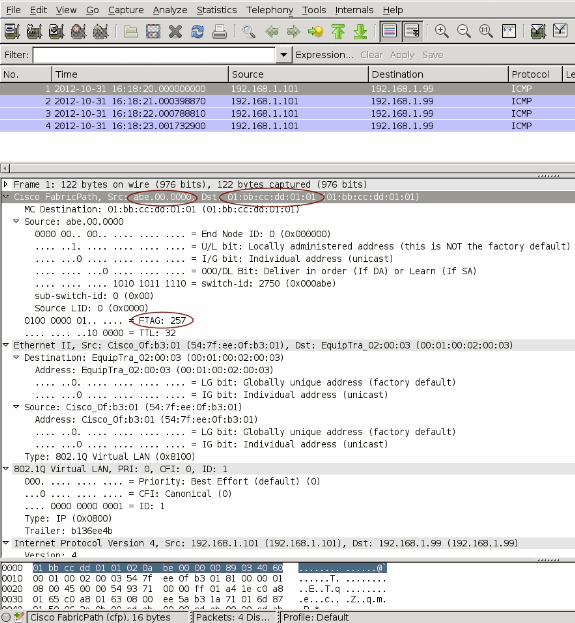
-
Since the frame ingresses via a vPC(vPC 111), source switch-id is abe.00.0000
-
Destination is a multicast MAC 01:bb:cc:dd:01:01
-
FTAG is 257.
When this frame comes into the vPC primary switch, it will inspect the FTAG 257. Because only orphan ports are members of FTAG 257, this vPC primary will flood this frame only to orphan port Eth 1/32.
Due to the above mechanism, the following is the flow for the flooded traffic coming into the vPC secondary switch.
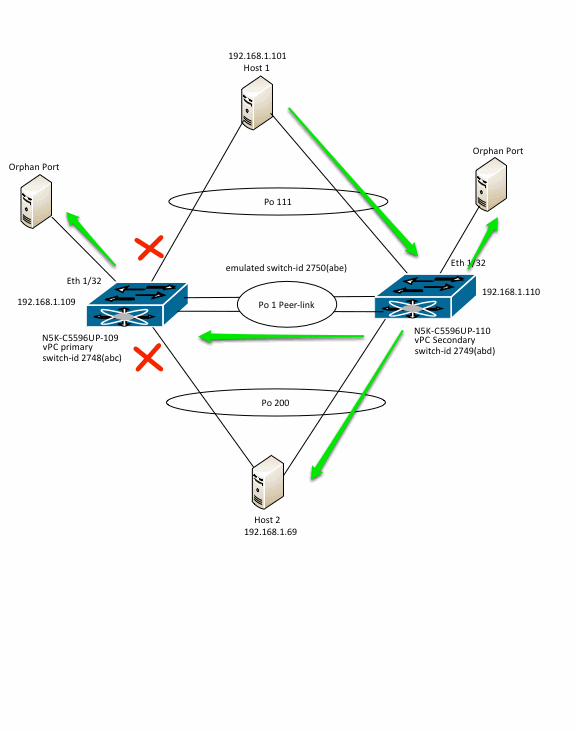
Test 3: Broadcast ARP traffic coming into vPC Primary
A non-existent IP 192.168.1.200 is pinged from host 2(192.168.1.69). Due to this, host 2 keeps sending out a broadcast ARP request asking "who is 192.168.1.200". Host 2 happens to hash this broadcast traffic to vPC Primary switch N5K-C5596UP-109, which in turn floods it to all ports in VLAN 1 including Po1 which is the vPC peer-link.
A TX SPAN of Port-channel 1 is captured to look at the fabric path headers of this ARP broadcast which is a multi-destination frame in FP terminology. Look at the fabric path header of this multi-destination frame.
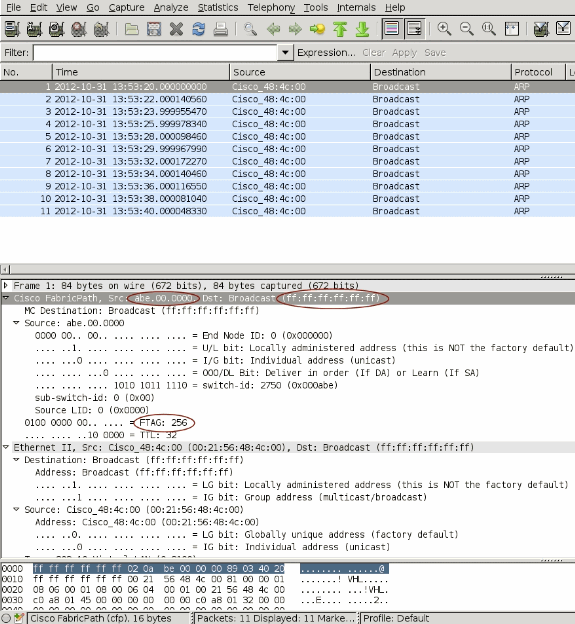
-
Since the frame ingresses via a vPC(vPC 200), source switch-id is abe.00.0000
-
Destination is a broadcast MAC FF:FF:FF:FF:FF:FF
-
FTAG is 256.
When this frame comes into the vPC secondary switch, it will inspect the FTAG 256. Because only orphan ports are members of FTAG 256, this broadcast ARP frame will only be sent to Eth 1/32.
Test 4: Unknown unicast frame coming into vPC Primary
In order to introduce unknown unicast traffic, on host 2, a static ARP for 192.168.1.200 is set up with a static MAC of 0003.0004.0005 and 192.168.1.200 is pinged. The ICMP echo request hashes to vPC primary N5K-C5596UP-109 and because it does not know where MAC 0003.0004.0005 is, it floods this frame in the VLAN including peer-link. A TX SPAN of Port-channel 1 is captured to look at the fabric path headers of this unknown unicast flood frame which is a multi-destination frame in FP terminology. Look at the fabric path header of this multi-destination frame.
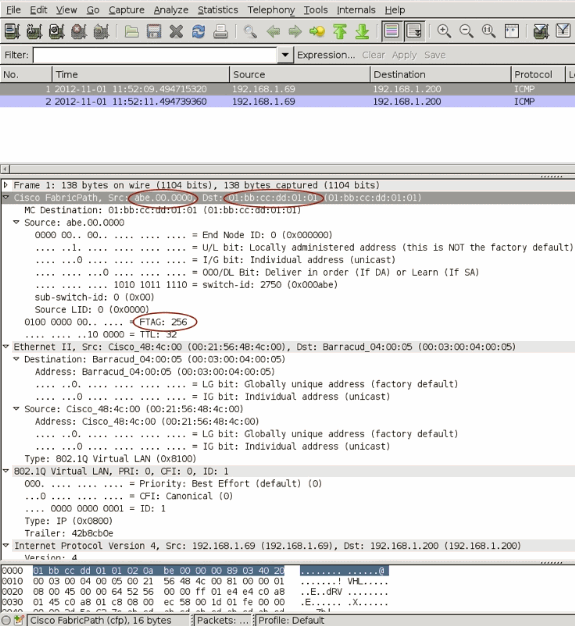
-
Since the frame ingresses via a vPC(vPC 200), source switch-id is abe.00.0000
-
Destination is a multicast MAC 01:bb:cc:dd:01:01 which is used for unknown unicast flooding
-
FTAG is 256.
When this frame comes into the vPC secondary switch, it will inspect the FTAG 257. Because only orphan ports are members of FTAG 256, this vPC primary will flood this frame only to orphan port Eth 1/32.
Due to the above mechanism, the following is the flow for the flooded traffic coming into the vPC Primary switch.
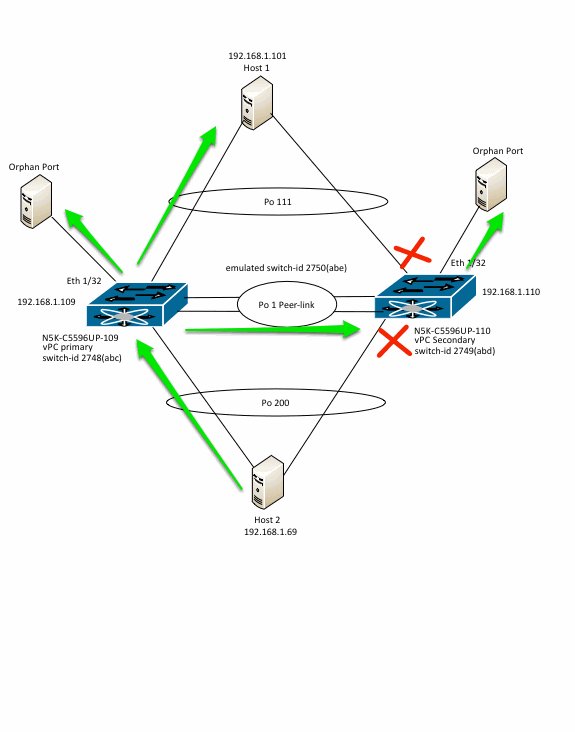
Related Information
Revision History
| Revision | Publish Date | Comments |
|---|---|---|
1.0 |
03-Jul-2014 |
Initial Release |
Contact Cisco
- Open a Support Case

- (Requires a Cisco Service Contract)
 Feedback
Feedback